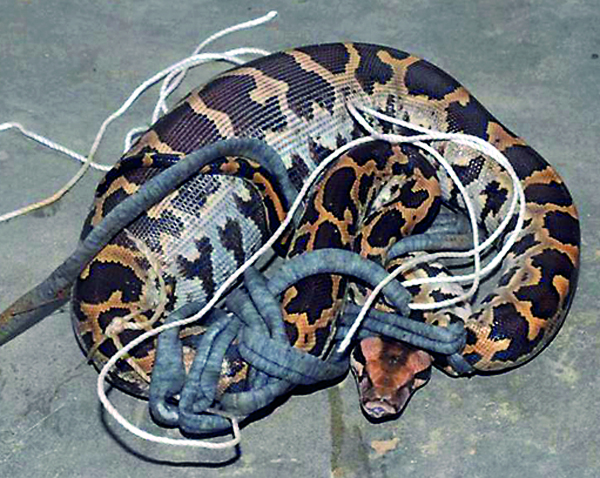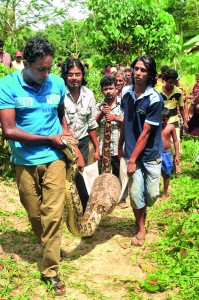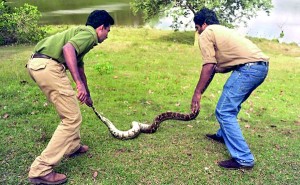News
Habitat destruction drives Cobras, Pythons to the cities
View(s):By Charundi Panagoda
Ecosystems of national parks could be adversely affected by officials releasing surplus snakes at zoos, into the wild.
Habitat destruction has driven cobras and pythons into the suburbs, with more and more incidents being reported of serpent sightings and snakebites inside homes, outside homes and even on buses. These snakes, most of them cobras, end up at the National Zoological Gardens (NZG- a.k.a the Dehiwala Zoo), either rescued by zoo officials, bred or handed over by suburban residents.
“Most people are afraid to kill cobras because of religious reasons and whatnot. So, when cobras are caught, they are handed over to the Zoo,” Galle Wildlife Conservation Society President Madura de Silva said. “That is simply why the Zoo is overflowing with cobras.”
NZG Deputy Director Dhammika Malsinghe said the Zoo gets at least one snake per week, usually from areas around Colombo. As the snakes keep coming, Zoo officials release the surplus into national parks such as Yala and Udawalawe. Last year, the Zoo released 240 snakes into national parks, 220 of them cobras and the rest vipers, said officer in charge of reptiles at the Zoo, Premasiri Pieris.
“We release about 50 to 60 snakes about every three months, with permission from the Department of Wildlife Conservation,” Mr. Pieris added. “We are doing the country a service, by rescuing and releasing these snakes, as people could get harmed or the snake could get killed.”
But zoologists warn of the well-intended operations having detrimental effects on wildlife at national parks. Mainly snakes, are prone to carry parasitic diseases that could put the healthy population at national parks at risk.
“There are many parasitic infections in snakes’ guts, and ectoparasites such as ticks and lice,” Dr. Madura de Silva said. “People bring these snakes in bottles or bags, which is very unhygienic, as many snakes are put together, and hence, obviously, diseases spread. And when these snakes go to Yala, they could infect the healthy population as well.”
Herpetologist Anslem de Silva said, “When ‘unnecessarily’ large numbers of cobras are dumped in one area, they can be destructive, feeding on animals and even other serpents.” Dr. Madura de Silva added that, cobras could be especially dangerous to birds that lay eggs on the ground.
“Cobras are mainly carnivorous animals that feed on amphibians and birds like the junglefowl and quails which lay eggs on the ground,” Dr. Madura de Silva said. “When large numbers of cobras start eating those eggs it could negatively affect those populations.”
“Though the Wet Zone cobras can create complications in national park ecosystems, there is no other alternative to conserve these snakes,” Dr. Madura de Silva added. Cobras are rare in Wet Zone rainforests, and because humans often venture into these areas, it’s not sensible to release cobras into forests. The root of the problem is that cobras like to frequent open, shrubby areas where mice are abound, and mice live where humans live.

A python caught by residents awaiting rescue
“Zoo officials are helpless regarding what to do with a large number of cobras,” Dr. Madura de Silva said. “It’s difficult to feed and keep that many cobras. They can’t just be returned to a residential area or a human habitat. You can’t dump the cobras in Asgiriya. So they send them to a non-contact area like Yala. Sri Lanka has a high number of deaths from snakebites, so saving lives takes priority. You can’t look at conservation all the time.”
There is an internationally accepted procedure for introducing animals into new habitats, drafted by the International Union for Conservation of Nature (IUCN) Re-Introduction Specialist Group. The guidelines for species re-introduction and translocation include assessments on genetic variations and taxonomy of populations, detailed studies of species’ behaviour, understanding the effects the new species will have on the ecosystem, health inspections to minimise disease spread, establishing an optimal number to be released per year, consulting with specialists and the cause of release should not be animal surplus.
Dr. Anslem de Silva said most of these guidelines are not followed in Sri Lanka and no adequate covering laws exist.
Translocation is when species are moved from one habitat to an alternate habitat, while re-introduction is when captive animals are reintroduced into a habitat from which they’ve been extinct or extirpated. Dr. Madura de Silva said translocation concerns are “not the case”, as cobras already exist in national parks. “Luckily, cobras found in the Wet Zone and those in the Dry Zone belong to the same subspecies, the Naja naja, also known as the Indian cobra, and the only distinguishable difference is that, Dry Zone cobras are lighter in colour,” he explained.
Unlike other countries, Sri Lanka lacks resources and the technology to identify genetic diversity, before species movement. “The biggest problem in Sri Lanka is that, there is not enough ecological information about snakes,” zoologist Ruchira Somaweera said.
“We don’t know how many snakes a forest can hold, without having a negative impact, which is a flaw in our natural history,” Dr. Somaweera added. “The Zoo is assuming there’s plenty of food in national parks for these snakes to feed. Not all these snakes are going to survive, as there will be birds of prey such as peacocks and owls that feed on snakes, while cobras also cannibalise each other. So,

Officers release a rescued python to the Hiyare forest. Pix courtesy of Wildlife Conservation Society Galle
not all snakes will survive, to cause too much damage.”
Ms. Malsinghe said veterinary surgeons at the Zoo conduct health inspections on the animals and health certifications are provided to the Wildlife Department, where the animals are inspected again. Mr. Pieris added that the Zoo would never release a sickly animal into the wild.
“There is no set number for optimal releases per year, and there are no behavioural studies conducted, unless outsider researchers choose to do so,” Mr. Pieris said. The snakes are sometimes marked to be examined if caught in the wild, and the Zoo does not conduct post-release screenings.
“This has happened for the past 20 or 25 years,” Ms. Malsinghe said. “We choose suitable areas for snakes, for which our veterinary surgeons are very capable and knowledgeable specialists. There’s also research under way to see if the released snakes migrate back to the Wet Zone.”
Dr. Somaweera said it’s not economically feasible in Sri Lanka to conduct studies and screenings as recommended by the guidelines, as the required equipment such as radio trackers are quite expensive. It’s an added endeavour to monitor the already cryptic and

Officers rescusing a python at Nakiyadeniya
secretive cobras. Other countries, such as Australia, euthanise surplus animals, out of concern for ecological impact and disease risk of introducing animals into a new environment. Dr. Somaweera said such an act would most likely be culturally unacceptable in Sri Lanka.
“All this releasing is a tricky situation,” he added. “I believe the Zoo is doing whatever they can to save the animals, as well as prioritise people’s safety. These translocations have to be done according to proper guidelines, but we don’t have enough economic power to conduct long-term monitoring and enforce all those guidelines. In fact, all stakeholders—government departments, universities, researchers—should be involved in this.”
Follow @timesonlinelk
comments powered by Disqus



















